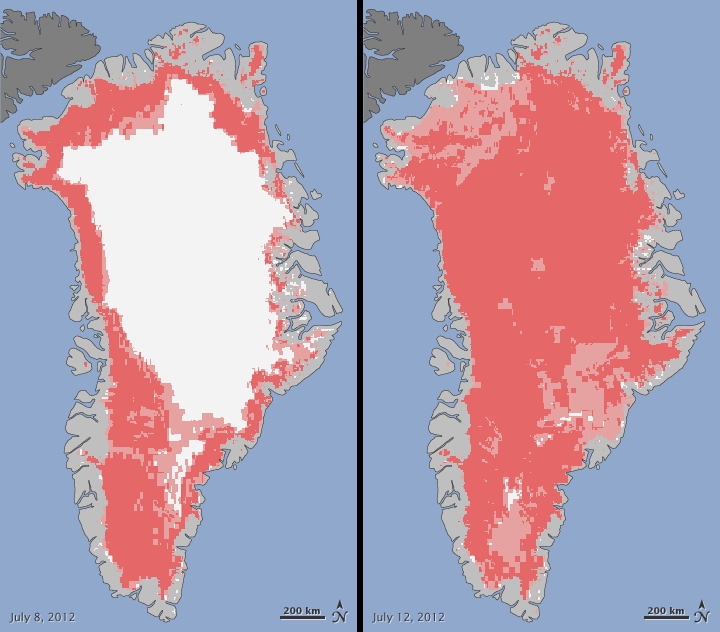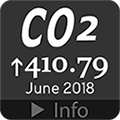We have a very dynamic planet. Throughout it’s geological evolution ice sheets grew and shrunk many times. This process still continues each year through a number of rather complex interactions between land, atmosphere and ocean. Climate science is working hard to measure, document and understand these interactions both on land and from orbit. Satellite missions launched in 1990s produced some very informative estimates about polar regions. Scientists are now collaborating to detail these observations from land measuring the mass balance of glaciers. Juneau Ice Field in Alaska is the 5th largest terrestrial ice region on Earth containing 50 glaciers.
The first half of this Earth Focus Report focuses on field work and introduces techniques glaciologist use. The loss of Arctic sea ice and it’s effects on mid-lattitude (temperate zone) weather events is also discussed. Reduced albedo (reflectance) in the Arctic can indeed trigger a cascade of climatic events. Imagine a dark light absorbing Arctic waters instead of reflective white sea ice. The remainder of the program is about climate policy and resistance against IPCC (Intergovernmental Panel on Climate Change) reports that amounts to anti-science largely funded by fossil fuel industries.
Global warming is giving dire signs around the cryosphere. Scientists working on both poles now agree that ice caps are melting. Sudden melt observed in Greenland during July 2012 alarmed scientists. On July 12th 2012, close to 97 percent of Greenland’s ice began to melt:
The Arctic ice sheet has been decreasing and in 2011 it reached a record low. Decrease was so historical that for the first time two German cargo ships passed through the Northeast seaway without any aid from icebreakers. Soon the entire North Sea will be ice free:
Decline in the Arctic Sea Ice Cover 1979-2011 from Uzay Sezen on Vimeo.
Antarctica’s extreme isolation due to the strong circumpolar ocean currents that are not obstructed by land masses, made it a very resilient part of the cryosphere for more than 34 million years since present. Glaciologist Eric Rignot of the Jet Propulsion Laboratory – NASA used very strong statements that we rarely hear from scientists. Melting ice caps have received media attention before, but Rignot claims the point of no return has been passed and now there’s no power strong enough to reverse collapse of the glaciers in the Antarctic:
Point of No Return for West Antarctic Glaciers from Uzay Sezen on Vimeo.
Until now scientists were optimistic that a runaway global warming event could be avoided as long as global average temperature increase was kept below 2 degrees Celcius. Now it is increasingly becoming clear that even below 2 degrees Celcius threshold the Earth can experience rapid global warming and sea level rise.
Climate science defines a number of major feedback mechanisms that has pushed the earth into rapid climate change many times in the earths geological past. We already mentioned change in cryospheric albedo. The meltwater can alter ocean circulation changing the heat distribution patterns. Geologists are finding new clues to explain an abrupt cooling period known as Younger Dryas which was largely influential in recent human prehistory corresponding to a time period (11 thousand years before present) immediately before the beginning of agriculture. By the end of the last ice age meltwater from the Laurentide Ice Sheet made a massive discharge into the North Atlantic through what is now Saint Lawrence Channel. Meltwater caused the shut down of the Atlantic Meridional Overturning Circulation (AMOC) and triggered the Younger Dryas event.
Another feedback mechanism is methane trapped in permafrost and cold ocean bottoms which has a big potential to accelerate warming when released into the atmosphere. As discussed in the documentary the weather patterns in temperate zone will respond to these changes almost instantaneously since the jet stream around the earth is finicky and can shift fast along north-south. The most notable warming period experienced in the past is a period known as the Paleocene-Eocene Thermal Maximum (PETM) at about 56 million years ago. PETM is largely attributed to atmospheric carbon levels. At the start of the PETM, average global temperatures increased by approximately 6 °C (11 °F) within about 20,000 years. Today even the most conservative temperature and precipitation estimates are calculating that the speed of warming is many times faster than recorded during PETM. Clathrate gun hypothesis summarizes how trapped methane residues can get released into the atmosphere in bursts of rapid succession. Unfortunately, the hypothesis seems to becoming a reality since large craters began appearing in Siberian soils which resemble bombholes. Russian scientists attribute their formation due to methane release predicted by the clathrate gun hypothesis.
Response to climate change is expected to be 10 to 12 times faster in polar regions compared to temperate zones. To emphasize the importance of poles the year 2007 was declared International Polar Year. We will continue to watch this space as the atmospheric carbon levels continue to soar.




2 Comments